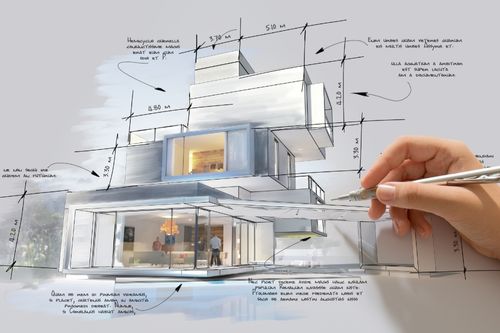Exactly How CDA Architects Deliver Cutting-Edge Solutions for Sustainable Design
Exactly How CDA Architects Deliver Cutting-Edge Solutions for Sustainable Design
Blog Article
Recognizing the Collaborative Refine In Between Architects and Engineers in Modern Building And Construction Projects
The collective process in between designers and engineers is important in modern-day building tasks, as it harmonizes layout intent with engineering feasibility. Checking out these dynamics discloses insights that might significantly impact project outcomes and general sector criteria.
The Importance of Collaboration
The collaborative synergy between designers and designers is crucial for the successful awareness of any type of building job. This partnership combines distinct knowledge and point of views, making it possible for the integration of cutting-edge style with functional design options. By collaborating, architects and engineers can ensure that a job not just meets visual and practical demands yet likewise sticks to security, sustainability, and monetary restraints.
Partnership fosters a shared vision, promoting the alignment of objectives and assumptions from the start. This positioning is critical in attending to prospective challenges and mitigating threats that can arise throughout the project lifecycle. A collective method enables for the effective allowance of resources, maximizing both time and price.
The relevance of partnership prolongs to the repetitive process of style and building and construction, where comments from engineers can educate architectural choices, leading to even more possible and lasting layouts. Alternatively, engineers can inspire designers to think artistically concerning exactly how to achieve architectural integrity without endangering creative intent. Eventually, the joint partnership in between architects and designers is not merely valuable; it is basic to the creation of top quality, functional, and cutting-edge developed settings that satisfy the needs of culture.
Interaction Techniques and Devices
Effective communication strategies and tools are crucial for promoting cooperation in between engineers and designers throughout the job lifecycle. Establishing clear channels of communication is necessary to make certain that all employee are straightened with project goals, timelines, and duties. Routine conferences, both in-person and online, supply opportunities for stakeholders to go over development, address concerns, and make educated choices.
Making use of project administration software, such as BIM (Structure Info Modeling) platforms, enhances collaboration by making it possible for real-time sharing of layout alterations and technological requirements. These devices facilitate transparency, enabling architects and engineers to visualize modifications and examine their impact on the total task.

Shared Objectives and Project Vision

Establishing shared objectives includes open dialogue and a comprehensive understanding of each technique's contributions. Architects typically concentrate on design intent, spatial connections, and customer experience, while designers stress architectural integrity, systems performance, and compliance with policies (cda architects). When these point of views are aligned, the result is a cohesive job that sticks to both imaginative desires and technical expediency
Furthermore, a distinct job vision fosters accountability amongst group participants, motivating each participant to take ownership of their function in accomplishing the wanted result. Routine check-ins and joint workshops can even more strengthen this commitment, enabling adjustments to be made as the project develops. Ultimately, a shared vision not only boosts synergy however additionally raises the high quality of the last our website deliverable, bring about successful project completion.
The Duty of Technology
Leveraging innovation has ended up being crucial in boosting cooperation in between engineers and designers. The integration of sophisticated software program tools facilitates real-time interaction and info sharing, allowing groups to function extra effectively and efficiently. Structure Info Modeling (BIM) stands apart as a crucial innovation, allowing both designers and designers to produce comprehensive 3D versions that envelop layout intent and architectural honesty. This common graph reduces misconceptions and improves the decision-making process.
Moreover, cloud-based platforms make it possible for seamless collaboration, enabling project stakeholders to access and upgrade task data from anywhere. This promotes a culture of transparency and responsibility, as adjustments can be tracked and evaluated in real-time. In addition, mobile applications additional boost interaction, giving on-site groups with immediate accessibility to task specs and updates.
Arising modern technologies such as man-made intelligence and device understanding are also beginning to play a company website duty in predictive analysis, aiding groups identify possible issues before they emerge. Eventually, the function of innovation in architecture-engineering partnership not only improves operations performances yet likewise boosts advancement, leading to more effective task outcomes. By welcoming these technological innovations, designers and engineers can ensure a much more cohesive and productive joint process throughout the building lifecycle.
Study in Effective Partnerships
Many study show the extensive impact of efficient partnerships in between architects and engineers on job results. One significant example is the collaboration on the High Line in New York City City, where landscape engineers, designers, and city organizers interacted to transform a deserted railway right into a vibrant public park. This multidisciplinary approach not just improved the visual top quality however likewise made certain architectural security and ecological sustainability.
One more excellent case is the layout and building of the Sydney Music Hall. The partnership in between architect JÃ ¸ rn Utzon and architectural engineer Ove Arup exhibited cutting-edge problem-solving. Their partnership enabled the iconic shell-like layout while addressing complex engineering difficulties, eventually leading to a classic building work of art.
The Burj Khalifa in Dubai even more demonstrates the relevance of collaborative initiatives. cda architects. The combination of design and engineering experience enabled the task group to attain unmatched heights while adhering to safety and security regulations and aesthetic vision
These instances underscore the significance of interaction, trust fund, and shared objectives. In today's complicated construction Read Full Article environment, such partnerships are important to navigating challenges and supplying projects that fulfill both functional and visionary objectives.
Final Thought
In verdict, the collaboration in between designers and designers is crucial for the success of contemporary building and construction projects. Reliable communication strategies, a shared task vision, and the combination of innovative technologies are essential components that facilitate this partnership.
Report this page